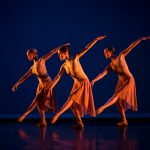Musical Theater is a great way to combine many performing talents. Whether you’re an actor, dancer, singer or musician, musical theater can showcase everything you have to offer.
Musical Theater is a form on theatrical performance that combines singing, playing instruments, spoken language, acting and dance, all while dressed head to toe in costumes, basking under the stage lights.
Modern, western Musical Theater came to be during the 19th century, although, music has been a part of dramatic presentations since ancient times. Now, simply called “musicals” (a condensed term started in the 20th century), some can be confused as to what Musical Theater actually is. This complex form of performance is often times lumped together with other performing arts, like opera and dance, but what really sets Musical Theater apart from the rest is, it gives an equal importance to the music as compared to the dialogue, movement and other elements.
A little history of how Musical Theater came to be… During the 19th century, in America, Edward Harrigan and Tony Hart formed one of the most celebrated theatrical partnerships of the 19th century. One half of this partnership was Edward Harrigan, who went by Ned. He was an actor, singer, dancer, playwright, lyricist and theater producer. The other half of this dynamic duo was Tony Hart (born Anthony J. Cannon) had many talents himself. He was an actor, comedian and singer. The two men formed multi-act plays full of singing, dancing and physical comedy.
During that same time period, in Britain, many structural elements were established by the works of musicians W. S. Gilbert and Arthur Sullivan. Known at Gilbert and Sullivan, this theatrical partnership between Gilbert, a librettist (an author of musical shows, similar to a screenplay writer) and Sullivan, a composer, lead to fourteen “comic operas” between 1871 and 1896. A comic opera is a show performance lead in song, with a light or comic nature, usually with a happy ending.
The work of Gilbert and Sullivan was followed by numerous Edwardian musical comedies. These types of comedies started in Britain as a form of musical theater that became popular once Gilbert and Sullivan’s dominance in the field had ended.
Back in America, Musical Theater was undergoing a transformation as well. The physical look of the theater was changing with the rise of the “Princess Theater”. It was one of the smallest Broadway theaters when it opened in 1913. Located just off Sixth Avenue in New York City, it seated only 299 people. Though small, the theater was very popular and saw many shows, leaving a grand effect on the development of American Musical Theater by inspiring the next generation of writers and composers.
During the 20th century, now just called “Musicals”, Musical Theater become widely popular. Some of the most iconic musicals include “Show Boat” (1927) and “Oklahoma!” (1943).
Musicals continue to be a staple in the performance world. Some of the most famous musicals through the decades include “West Side Story” (1957), “The Fantasticks” (1960), “Hair” (1967), “A Chorus Line” (1975), “Les Miserables” (1985), “The Phantom of the Opera” (1986), “Rent” (1996), “The Producers” (2001), “Wicked” (2003) and “Hamilton” (2015).
Register for our Musical Theater Class at OSMD and learn even more!! Check out our website for more information! https://omahaschoolofmusicanddance.com/musical-theater-omaha-ne/



